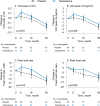Long-Term Testosterone Supplementation in Older Men Attenuates Age-Related Decline in Aerobic Capacity
- PMID: 29846604
- PMCID: PMC6669813
- DOI: 10.1210/jc.2017-01902
Long-Term Testosterone Supplementation in Older Men Attenuates Age-Related Decline in Aerobic Capacity
Abstract
Context: Testosterone increases skeletal muscle mass and strength, but long-term effects of testosterone supplementation on aerobic capacity, or peak oxygen uptake (V̇O2peak), in healthy older men with low testosterone have not been evaluated.
Objective: To determine the effects of testosterone supplementation on V̇O2peak during incremental cycle ergometry.
Design: A double-blind, randomized, placebo-controlled, parallel-group trial (Testosterone's Effects on Atherosclerosis Progression in Aging Men).
Setting: Exercise physiology laboratory.
Participants: Healthy men aged ≥ 60 years with total testosterone levels of 100 to 400 ng/dL (3.5 to 13.9 nmol/L) or free testosterone levels < 50 pg/mL (174 pmol/L).
Interventions: Randomization to 1% transdermal testosterone gel adjusted to achieve serum levels of 500 to 950 ng/dL or placebo applied daily for 3 years.
Main outcome measures: Change in V̇O2peak.
Results: Mean (±SD) baseline V̇O2peak was 24.2 ± 5.2 and 23.6 ± 5.6 mL/kg/min for testosterone and placebo, respectively. V̇O2peak did not change in men treated with testosterone but fell significantly in men receiving placebo (average 3-year decrease, 0.88 mL/kg/min; 95% CI, -1.39 to 0.38 mL/kg/min; P = 0.035); the difference in change in V̇O2peak between groups was significant (average 3-year difference, 0.91 mL/kg/min; 95% CI, 0.010 to 0.122 mL/kg/min; P = 0.008). The 1-g/dL mean increase in hemoglobin (P < 0.001) was significantly associated with changes in V̇O2peak in testosterone-treated men.
Conclusion: The mean 3-year change in V̇O2peak was significantly smaller in men treated with testosterone than in men receiving placebo and was associated with increases in hemoglobin. The difference in V̇O2peak change between groups may indicate attenuation of its expected age-related decline; the clinical meaningfulness of the modest treatment effect remains to be determined.
Trial registration: ClinicalTrials.gov NCT00240981.
Figures




Comment in
-
Re: Long-Term Testosterone Supplementation in Older Men Attenuates Age-Related Decline in Aerobic Capacity.J Urol. 2019 Jan;201(1):14. doi: 10.1097/01.ju.0000550118.33200.15. J Urol. 2019. PMID: 30577345 No abstract available.
References
-
- Bhasin S, Pencina M, Jasuja GK, Travison TG, Coviello A, Orwoll E, Wang PY, Nielson C, Wu F, Tajar A, Labrie F, Vesper H, Zhang A, Ulloor J, Singh R, D’Agostino R, Vasan RS. Reference ranges for testosterone in men generated using liquid chromatography tandem mass spectrometry in a community-based sample of healthy nonobese young men in the Framingham Heart Study and applied to three geographically distinct cohorts. J Clin Endocrinol Metab. 2011;96(8):2430–2439. - PMC - PubMed
-
- Wu FC, Tajar A, Beynon JM, Pye SR, Silman AJ, Finn JD, O’Neill TW, Bartfai G, Casanueva FF, Forti G, Giwercman A, Han TS, Kula K, Lean ME, Pendleton N, Punab M, Boonen S, Vanderschueren D, Labrie F, Huhtaniemi IT, Group E; EMAS Group . Identification of late-onset hypogonadism in middle-aged and elderly men. N Engl J Med. 2010;363(2):123–135. - PubMed
-
- Roy TA, Blackman MR, Harman SM, Tobin JD, Schrager M, Metter EJ. Interrelationships of serum testosterone and free testosterone index with FFM and strength in aging men. Am J Physiol Endocrinol Metab. 2002;283(2):E284–E294. - PubMed
-
- Krasnoff JB, Basaria S, Pencina MJ, Jasuja GK, Vasan RS, Ulloor J, Zhang A, Coviello A, Kelly-Hayes M, D’Agostino RB, Wolf PA, Bhasin S, Murabito JM. Free testosterone levels are associated with mobility limitation and physical performance in community-dwelling men: the Framingham Offspring Study. J Clin Endocrinol Metab. 2010;95(6):2790–2799. - PMC - PubMed
-
- Bhasin S, Woodhouse L, Casaburi R, Singh AB, Mac RP, Lee M, Yarasheski KE, Sinha-Hikim I, Dzekov C, Dzekov J, Magliano L, Storer TW. Older men are as responsive as young men to the anabolic effects of graded doses of testosterone on the skeletal muscle. J Clin Endocrinol Metab. 2005;90(2):678–688. - PubMed
Publication types
MeSH terms
Substances
Associated data
Grants and funding
LinkOut - more resources
Full Text Sources
Other Literature Sources
Medical

